MINI COOPER 2005 Owners Manual
Manufacturer: MINI, Model Year: 2005, Model line: COOPER, Model: MINI COOPER 2005Pages: 165, PDF Size: 4.64 MB
Page 91 of 165
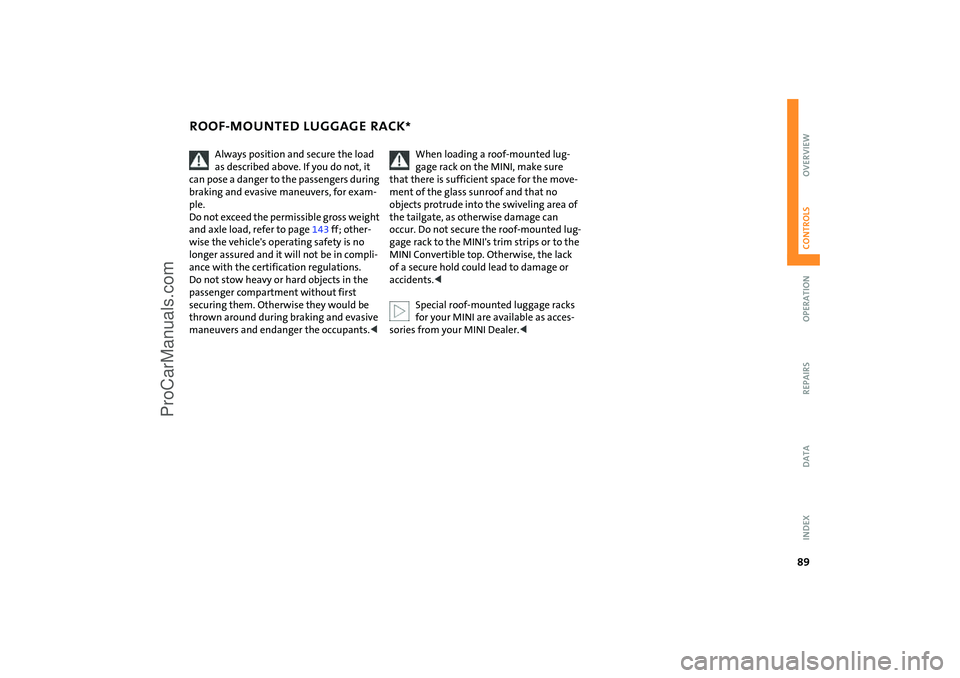
89
OVERVIEW REPAIRS OPERATIONCONTROLS DATA INDEX
ROOF-MOUNTED LUGGAGE RACK
*
Always position and secure the load as described above. If you do not, it
can pose a danger to the passengers during
braking and evasive maneuvers, for exam
-
ple.
Do not exceed the permissible gross weight
and axle load, refer to page
143
ff; other
-
wise the vehicle's operating safety is no
longer assured and it will not be in compli
-
ance with the certification regulations.
Do not stow heavy or hard objects in the
passenger compartment without first
securing them. Otherwise they would be
thrown around during braking and evasive
maneuvers and endanger the occupants.<
When loading a roof-mounted lug
-
gage rack on the MINI, make sure
that there is sufficient space for the move
-
ment of the glass sunroof and that no
objects protrude into the swiveling area of
the tailgate, as otherwise damage can
occur. Do not secure the roof-mounted lug
-
gage rack to the MINI's trim strips or to the
MINI Convertible top. Otherwise, the lack
of a secure hold could lead to damage or
accidents.<
Special roof-mounted luggage racks for your MINI are available as acces
-
sories from your MINI Dealer.<
ProCarManuals.com
Page 92 of 165
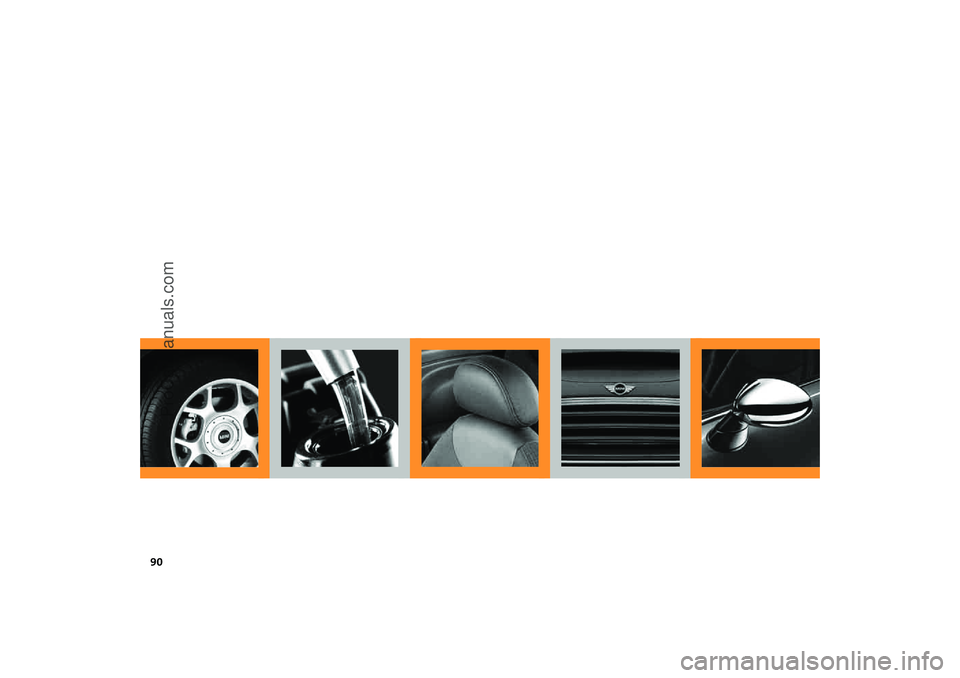
90
ProCarManuals.com
Page 93 of 165
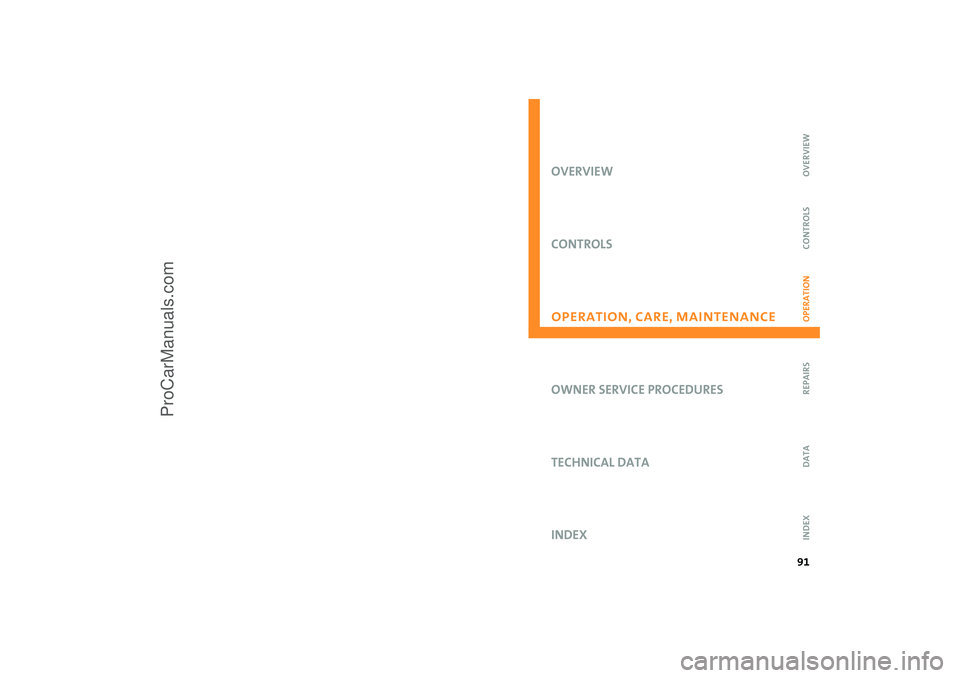
OVERVIEW
CONTROLS
OPERATION, CARE, MAINTENANCE
OWNER SERVICE PROCEDURES
INDEX TECHNICAL DATA
91
OVERVIEW REPAIRSOPERATIONCONTROLS DATA INDEX
Operation
ProCarManuals.com
Page 94 of 165
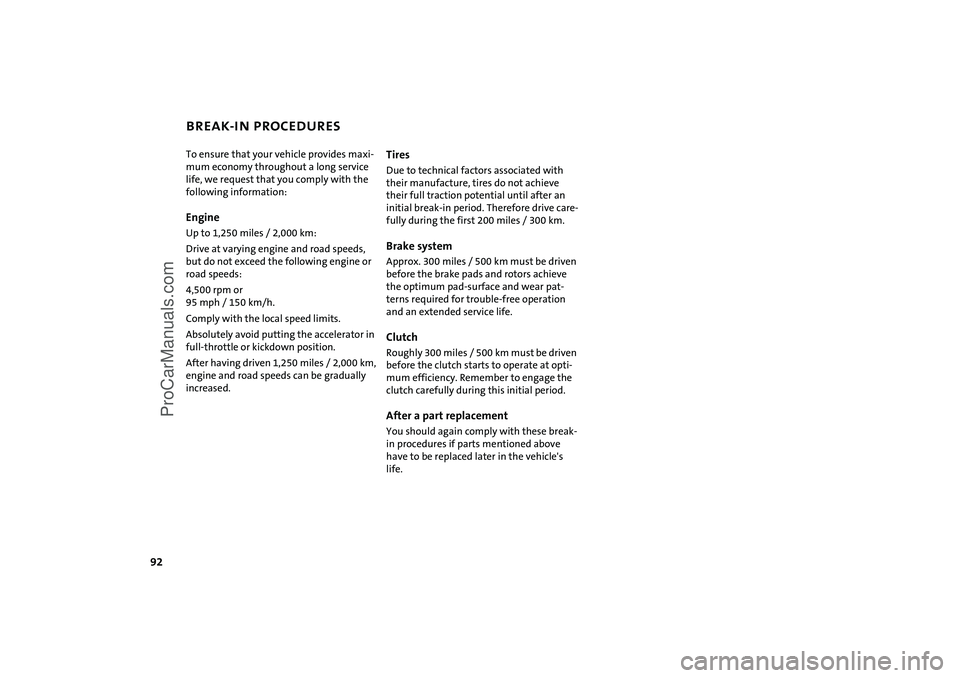
92
BREAK-IN PROCEDURES To ensure that your vehicle provides maxi
-
mum economy throughout a long service
life, we request that you comply with the
following information: EngineUp to 1,250
miles
/ 2,000
km:
Drive at varying engine and road speeds,
but do not exceed the following engine or
road speeds:4,500
rpm or
95 mph
/ 150
km/h.
Comply with the local speed limits.Absolutely avoid putting the accelerator in
full-throttle or kickdown position.After having driven 1,250
miles
/ 2,000
km,
engine and road speeds can be gradually
increased.
TiresDue to technical factors associated with
their manufacture, tires do not achieve
their full traction potential until after an
initial break-in period. Therefore drive care
-
fully during the first 200
miles
/ 300
km.
Brake systemApprox. 300
miles
/ 500
km must be driven
before the brake pads and rotors achieve
the optimum pad-surface and wear pat
-
terns required for trouble-free operation
and an extended service life.ClutchRoughly 300
miles
/ 500
km must be driven
before the clutch starts to operate at opti
-
mum efficiency. Remember to engage the
clutch carefully during this initial period.After a part replacementYou should again comply with these break-
in procedures if parts mentioned above
have to be replaced later in the vehicle's
life.
ProCarManuals.com
Page 95 of 165

93
OVERVIEW REPAIRSOPERATIONCONTROLS DATA INDEX
GENERAL DRIVING NOTESParking the vehicle Condensation forms in the air conditioner
system during operation, and then exits
under the vehicle. Traces of condensed
water on the ground are therefore normal.Safe braking Your vehicle is equipped with ABS as a stan
-
dard feature. The best way to brake the
vehicle in critical situations requiring brak
-
ing is to apply maximum pressure to the
brake pedal: panic stop. Since the vehicle
remains maneuverable, you can still go
around any obstacles with the smallest
possible steering movements. The pulsation of the brake pedal, together
with the sound of hydraulic regulation,
indicates to you that ABS is actively taking
effect. Hydroplaning
When driving on wet or slushy roads, reduce road speed. If you do not, a
wedge of water can form between tires
and road surface. This phenomenon is char
-
acterized by a partial or complete loss of
contact between the tires and the road sur
-
face. The ultimate results are loss of steer
-
ing and braking control.<
Mobile communications in the vehicle
The manufacturer of your MINI
recommends that you do not use
mobile devices, e.g. cellular phones, inside
the vehicle without directly connecting
them to an outside antenna. Otherwise,
interference between the vehicle electron
-
ics and the mobile device cannot be ruled
out. In addition, it is not ensured that the
radiation emitted during mobile transmis
-
sion will be directed outside of the vehi
-
cle.
ft / 30 cm,
and then only at walking speed at the
most. Otherwise, the vehicle's engine, the
electrical systems and the transmission
may be damaged.<
Clothes hooks
When suspending clothing from the hooks, ensure that they will not
obstruct the driver's vision. Do not hang
heavy objects on the hooks. If you do, they
could injure the occupants during braking
or evasive maneuvers.<
Hot exhaust system
High temperatures occur in any vehi
-
cle equipped with a catalytic con
-
verter. Do not remove the heat protection
plates fitted in the area of the exhaust sys
-
tem and do not apply body-cavity pro
-
tectant to this area. When driving, standing
at idle, and parking the vehicle, take care to
avoid contact between the hot exhaust sys
-
tem and flammable materials, e.g. hay,
grass, leaves, etc. Such contact could lead
to a fire resulting in serious personal injury
and property damage.<
ProCarManuals.com
Page 96 of 165
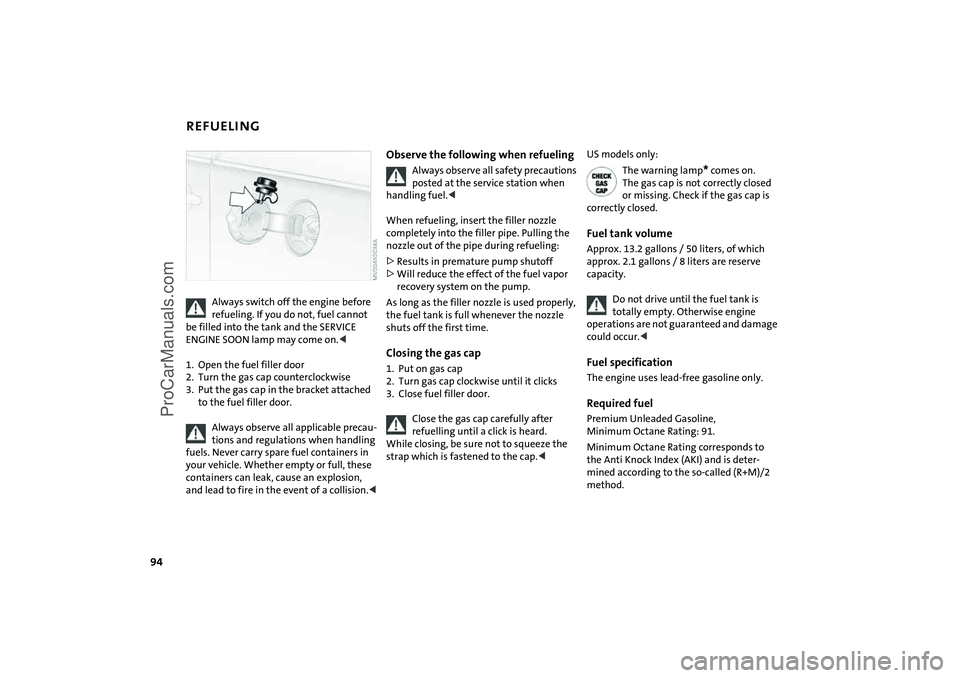
94
REFUELING
Always switch off the engine before refueling. If you do not, fuel cannot
be filled into the tank and the SERVICE
ENGINE SOON lamp may come on.<
1. Open the fuel filler door2. Turn the gas cap counterclockwise3. Put the gas cap in the bracket attached
to the fuel filler door.
Always observe all applicable precau
-
tions and regulations when handling
fuels. Never carry spare fuel containers in
your vehicle. Whether empty or full, these
containers can leak, cause an explosion,
and lead to fire in the event of a collision.<
Observe the following when refueling
Always observe all safety precautions posted at the service station when
handling fuel.<
When refueling, insert the filler nozzle
completely into the filler pipe. Pulling the
nozzle out of the pipe during refueling:>Results in premature pump shutoff>Will reduce the effect of the fuel vapor
recovery system on the pump.As long as the filler nozzle is used properly,
the fuel tank is full whenever the nozzle
shuts off the first time.Closing the gas cap1. Put on gas cap 2. Turn gas cap clockwise until it clicks3. Close fuel filler door.
Close the gas cap carefully after
refuelling until a click is heard.
While closing, be sure not to squeeze the
strap which is fastened to the cap.<
US models only:
The warning lamp
* comes on.
The gas cap is not correctly closed
or missing. Check if the gas cap is
correctly closed.
Fuel tank volumeApprox. 13.2
gallons
/ 50
liters, of which
approx. 2.1
gallons
/ 8
liters are reserve
capacity.
Do not drive until the fuel tank is totally empty. Otherwise engine
operations are not guaranteed and damage
could occur.<
Fuel specification The engine uses lead-free gasoline only.Required fuel Premium Unleaded Gasoline,
Minimum Octane Rating: 91.Minimum Octane Rating corresponds to
the Anti Knock Index (AKI) and is deter
-
mined according to the so-called (R+M)/2
method.
ProCarManuals.com
Page 97 of 165

95
OVERVIEW REPAIRSOPERATIONCONTROLS DATA INDEX
REFUELING
Do not use leaded gasoline, as other
-
wise the lambda probe and catalytic
converter will be permanently damaged.<
Use high-quality brandsField experience has indicated significant
differences in fuel quality: volatility, com
-
position, additives, etc., among gasolines
offered for sale in the United States and
Canada. Fuels containing up to and includ
-
ing 10
% ethanol or other oxygenates with
up to 2.8 % oxygen by weight, that is, 15
%
MTBE or 3% methanol plus an equivalent
amount of co-solvent, will not void the
applicable warranties with respect to
defects in materials or workmanship.
The use of poor-quality fuels may result in driveability, starting and
stalling problems especially under certain
environmental conditions such as high
ambient temperature and high altitude.
Should you encounter driveability prob
-
lems which you suspect could be related to
the fuel you are using, we recommend that
you respond by switching to a recognized
high-quality brand.
Failure to comply with these recommenda
-
tions may result in unscheduled mainte
-
nance.<
Manual release with the MINI In the event of an electrical malfunction,
the fuel filler door can be unlocked manu
-
ally.1. Remove the side trim panel on the left-
hand side of the luggage compartment2. Pull the white lever toward the rear.
The fuel filler door is released
3. Open the fuel filler door.
Manual release with the MINI Convertible In the event of an electrical malfunction,
the fuel filler door can be unlocked manu
-
ally.1. Remove the cover of the side trim panel
on the left-hand side, arrow
1
2. Pull the green strap toward the rear,
arrow
2.
The fuel filler door is released
3. Open the fuel filler door.
ProCarManuals.com
Page 98 of 165
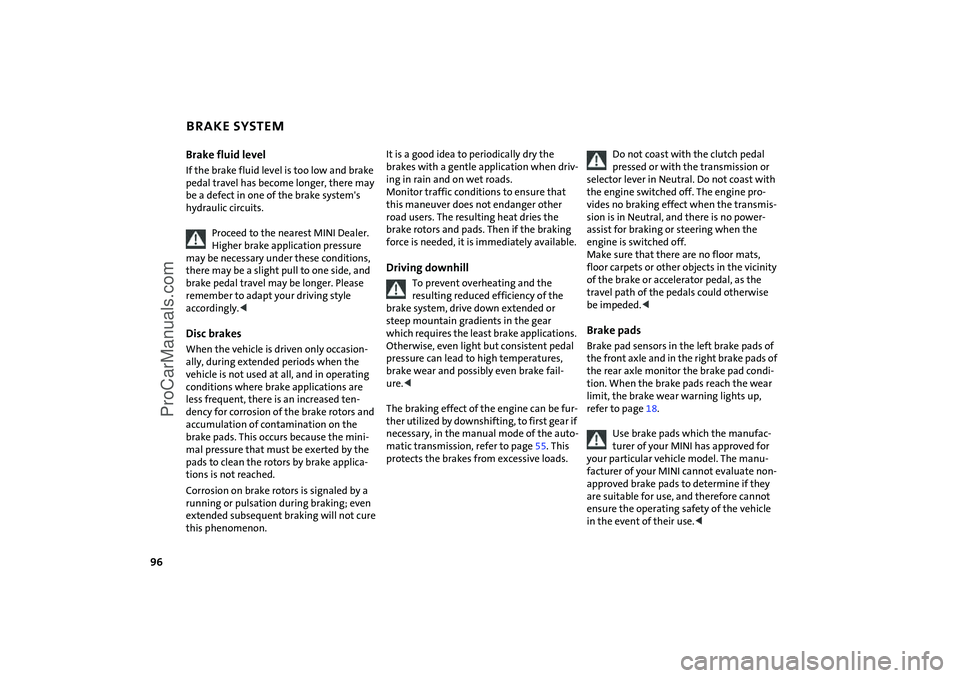
96
BRAKE SYSTEMBrake fluid levelIf the brake fluid level is too low and brake
pedal travel has become longer, there may
be a defect in one of the brake system's
hydraulic circuits.
Proceed to the nearest MINI Dealer. Higher brake application pressure
may be necessary under these conditions,
there may be a slight pull to one side, and
brake pedal travel may be longer. Please
remember to adapt your driving style
accordingly.<
Disc brakesWhen the vehicle is driven only occasion
-
ally, during extended periods when the
vehicle is not used at all, and in operating
conditions where brake applications are
less frequent, there is an increased ten
-
dency for corrosion of the brake rotors and
accumulation of contamination on the
brake pads. This occurs because the mini
-
mal pressure that must be exerted by the
pads to clean the rotors by brake applica
-
tions is not reached. Corrosion on brake rotors is signaled by a
running or pulsation during braking; even
extended subsequent braking will not cure
this phenomenon.
It is a good idea to periodically dry the
brakes with a gentle application when driv
-
ing in rain and on wet roads.
Monitor traffic conditions to ensure that
this maneuver does not endanger other
road users. The resulting heat dries the
brake rotors and pads. Then if the braking
force is needed, it is immediately available.Driving downhill
To prevent overheating and the resulting reduced efficiency of the
brake system, drive down extended or
steep mountain gradients in the gear
which requires the least brake applications.
Otherwise, even light but consistent pedal
pressure can lead to high temperatures,
brake wear and possibly even brake fail
-
ure.
ther utilized by downshifting, to first gear if
necessary, in the manual mode of the auto
-
matic transmission, refer to page
55. This
protects the brakes from excessive loads.
Do not coast with the clutch pedal pressed or with the transmission or
selector lever in Neutral. Do not coast with
the engine switched off. The engine pro
-
vides no braking effect when the transmis
-
sion is in Neutral, and there is no power-
assist for braking or steering when the
engine is switched off.
Make sure that there are no floor mats,
floor carpets or other objects in the vicinity
of the brake or accelerator pedal, as the
travel path of the pedals could otherwise
be impeded.
the rear axle monitor the brake pad condi
-
tion. When the brake pads reach the wear
limit, the brake wear warning lights up,
refer to page
18.
Use brake pads which the manufac
-
turer of your MINI has approved for
your particular vehicle model. The manu
-
facturer of your MINI cannot evaluate non-
approved brake pads to determine if they
are suitable for use, and therefore cannot
ensure the operating safety of the vehicle
in the event of their use.<
ProCarManuals.com
Page 99 of 165

97
OVERVIEW REPAIRSOPERATIONCONTROLS DATA INDEX
TIRE INFLATION PRESSURE Information for your safetyIt is not merely the tire's service life, but
also driving safety and driving comfort that
depend on the condition of the tires and
the maintenance of the specified tire pres
-
sure.
Check tire inflation pressures regu
-
larly and correct them if necessary,
including the space-saver spare tire: at
least twice a month and before long jour
-
neys. Failure to observe this precaution can
result in incorrect tire pressures, which
cause unstable handling response as well
as tire damage, and can ultimately lead to
an accident.
Do not drive with deflated, i.e. flat, tires
except if Run Flat tires are fitted. A flat tire
greatly impairs steering and braking
response, and can lead to complete loss of
control over the vehicle.
-
mum of 1.25
miles / 2
km or when the
vehicle has been parked for at least 2
hours.
Warm tires have higher pressures.
After correcting the tire inflation pressure,
reinitialize the Flat Tire Monitor, refer to
page
71.
Tire inflation pressures for original tiresThe tire inflation pressures for your stan
-
dard tires are shown on the driver's-side
door post, visible when the door is open.Tire inflation pressures for other tire
sizesIn the following tire pressure table, all pres
-
sures are given for the specified tire sizes at
ambient temperature.
In order to determine the correct inflation pressures for your tires,
refer to the values for the tire size in ques
-
tion.<
Checking the inflation pressure on the space-saver spare tireBehind the bumper there is a valve exten
-
sion accessible from the outside for check
-
ing the inflation pressure.Tire sizeThe tire inflation pressures apply to the tire
sizes approved and the tire brands recom
-
mended by the manufacturer of your MINI
or MINI Convertible. Your MINI Dealer will
be glad to advise you.
ProCarManuals.com
Page 100 of 165
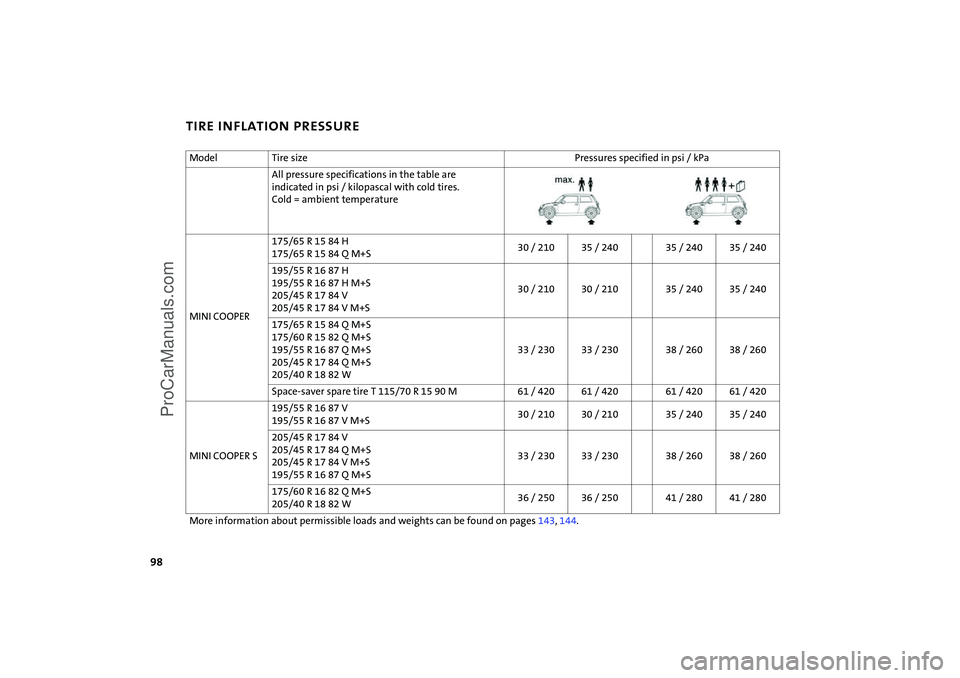
98
TIRE INFLATION PRESSUREModel
Tire size
Pressures specified in psi / kPa
All pressure specifications in the table are
indicated
in psi / kilopascal with cold tires.
Cold = ambient temperature
MINI COOPER
175/65 R 15 84 H175/65 R 15 84 Q M+S
30 / 210
35 / 240
35 / 240
35 / 240
195/55 R 16 87 H195/55 R 16 87 H M+S205/45 R 17 84 V205/45 R 17 84 V M+S
30 / 210
30 / 210
35 / 240
35 / 240
175/65 R 15 84 Q M+S175/60 R 15 82 Q M+S195/55 R 16 87 Q M+S205/45 R 17 84 Q M+S205/40 R 18 82 W
33 / 230
33 / 230
38 / 260
38 / 260
Space-saver spare tire T 115/70 R 15 90 M
61 / 420
61 / 420
61 / 420
61 / 420
MINI COOPER S
195/55 R 16 87 V195/55 R 16 87 V M+S
30 / 210
30 / 210
35 / 240
35 / 240
205/45 R 17 84 V205/45 R 17 84 Q M+S205/45 R 17 84 V M+S195/55 R 16 87 Q M+S
33 / 230
33 / 230
38 / 260
38 / 260
175/60 R 16 82 Q M+S205/40 R 18 82 W
36 / 250
36 / 250
41 / 280
41 / 280
More information about permissible loads and weights can be found on pages
143
, 144
.
ProCarManuals.com